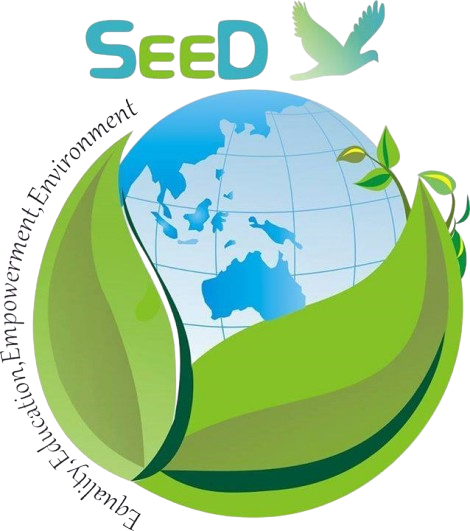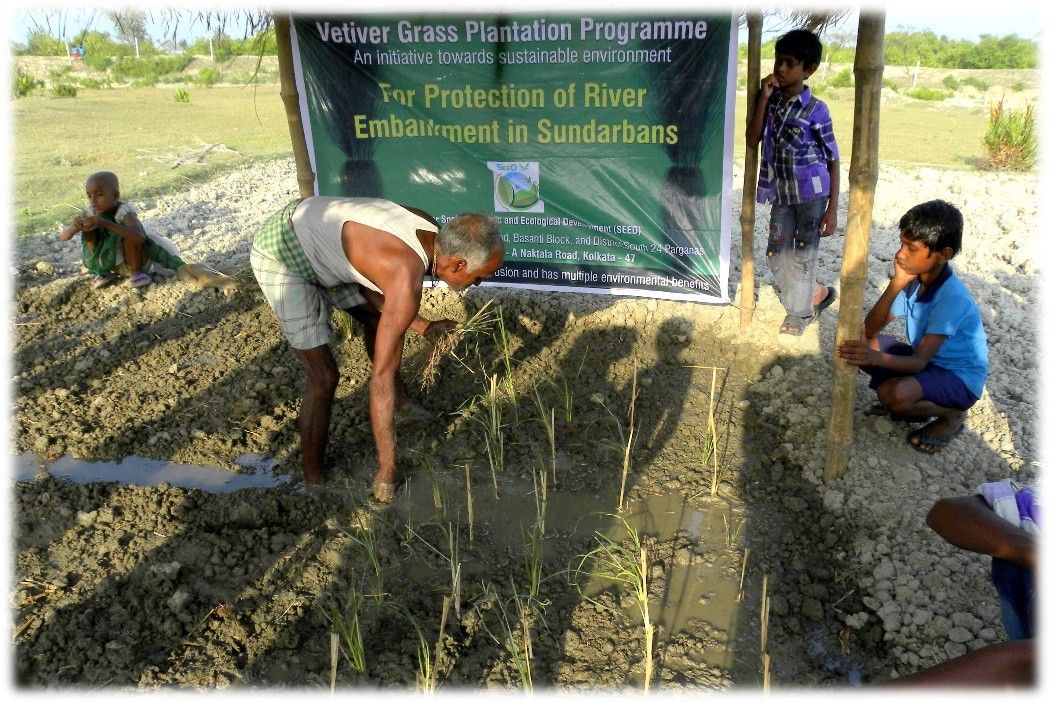






Objective:
To introduce vetiver grass (locally known as Binna) as a cost-effective, nature-based solution for protecting coastal river embankments against cyclonic tidal surges and erosion.
Overview:
The Sundarbans faces persistent challenges from coastal floods and cyclones that threaten the integrity of vital river embankments protecting island communi ties. Traditional embankment protection methods including geobags, geotextiles, concrete blocks and stone or wood revetments have proven expensive and often ineffective during their designed lives, failing repeatedly during natural disasters and leaving communities vulnerable to devastating storm surges.
In this context, SEED pioneered the first-time introduction of vetiver grass in the Indian Sundarbans on April 6, 2014, drawing inspiration from successful applications in Bangladesh and over 100 countries worldwide. This nature-based disaster risk reduction initiative was conceived and implemented by SEED’s President- Professor Jyotiranjan Naskar (Environmental Scientist) and Mr. Bhabananda Chatterjee (Environmental Activist), who recognized the urgent need for sustainable, cost-effective embankment protection solutions.
The pilot project commenced in Tridibnagar area of Basanti Block on Jharkhali Island, where the Jharkhali Gram Panchayat had provided land for establishing a resource centre and Marine Biodiversity Conservation Centre for vulnerable coastal communities. The site selection was strategic, chosen as a demonstration area with plans for subsequent extension to other parts of the island and broader Sundarbans region.
Vetiver grass represents a revolutionary approach to coastal protection through its exceptional soil stabilization properties. Studies demonstrate that rooted soil with vetiver achieves 87% higher shear strength and is 70% stronger than soil without vetiver roots. This remarkable root system creates a vegetative barrier of rigid, deeply rooted grass bunches that effectively resist erosion and tidal surge impacts while remaining environmentally sustainable and naturally compatible with Sundarbans soil conditions.
The methodology emphasized community participation and local ownership, with wholehearted support from residents who recognized the dual benefits of embankment protection and livelihood diversification. Unlike previous failed attempts using expensive artificial materials, vetiver grass offers a self-sustaining solution that grows naturally in local soil conditions while providing multiple economic opportunities through its versatile applications.
The project's innovative approach addresses the critical gap between disaster risk reduction needs and economic sustainability, demonstrating how nature-based solutions can simultaneously protect communities from climate hazards while creating new income streams. This pioneering initiative positions vetiver cultivation as both an adaptation strategy against climate change impacts and a foundation for resilient coastal livelihoods in the Sundarbans' challenging environmental context.
Impact:
First successful introduction of vetiver grass in Indian Sundarbans, establishing a cost-effective alternative to expensive artificial embankment protection methods that repeatedly failed during natural disasters.
Demonstrated 87% higher shear strength in rooted soil and 70% stronger soil stability compared to areas without vetiver roots, significantly enhancing coastal embankment resilience against cyclonic tidal surges.
Created vegetative barriers through rigid, deeply rooted grass bunches that effectively block surface water runoff and slow water flow velocity, reducing erosion and increasing soil water absorption.
Established pilot demonstration site in Tridibnagar area serving as a model for replication across other Sundarbans islands, with local community providing wholehearted support for expansion.
Introduced multipurpose livelihood opportunities through vetiver applications including house thatching, animal fodder production, handicraft manufacturing, and medicinal uses, diversifying income sources for vulnerable coastal communities.
Enhanced soil moisture retention through reduced evaporation and increased water infiltration, particularly beneficial for hot and dry conditions affecting agricultural sustainability.
Strengthened farming system sustainability in Jharkhali Island's rainfed areas through improved water management and soil conservation properties of vetiver cultivation.
Created environment-friendly solution addressing climate change and global warming impacts on Sundarbans islands through natural vegetation barriers rather than artificial interventions.
Generated community awareness about traditional Indian grass species applications, reviving indigenous knowledge for modern disaster risk reduction needs.
Established model for nature-based disaster risk reduction that combines immediate protection benefits with sustainable economic opportunities for climate-vulnerable populations.
Positioned vetiver cultivation as integral component of climate adaptation strategy, providing communities with tools to minimize disaster losses while building economic resilience.



Subscribe to the SEED Newsletter — and be part of the change!